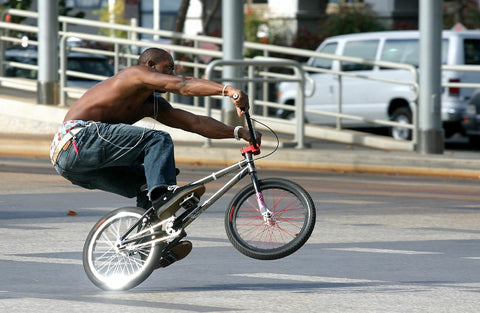Why Don’t BMX Bikes Have Brakes?
Have you ever marvelled at a BMX bike’s sleek design? Then you might have noticed a peculiar absence — brakes. In this guide, we’ll uncover the mystery behind this brakeless concept. So read on and learn what contributes to this unique feature, and see if foregoing the brakes suit you.
A Brief History

(Image Credit: Wallpaper Flare)
The evolution of BMX bikes is a journey through the history of extreme sports. It originated in the 1960s and gained prominence in the 1970s. In the early days, riders transformed cruiser bicycles for off-road racing and tricks. The decision to skip brakes was inspired by motocross, aiming for smooth, fluid ride like motorbikes. As the sport found its footing, the absence of brakes became a defining quality. This rebelled against norms and met the unique needs of BMX. It prioritises precision, speed, and manoeuvrability over traditional brakes. This historical context shapes the core of BMX culture through intentional design decisions.
Riding Style and Tricks

BMX riding is a lively mix of precision and style, marked by its distinct riding approach. Manoeuvrability stands as the heartbeat of this style. It emphasises the rider’s ability to navigate tight spaces with finesse. Surprisingly, the deliberate absence of brakes becomes a key player in this dance. BMX riders gain a unique freedom. This enables them to execute intricate tricks and techniques seamlessly.
The lack of brakes also enhances the rider’s control. This allows for swift turns, spins, and gravity-defying stunts. Thus, the intentional choice to go brakeless is not just a design quirk. It’s a strategic decision that amplifies the gravity-defying nature of BMX riding.
Weight and Performance
Weight plays a crucial role in shaping the design of BMX bikes. This factor influences their performance on the track. The inclusion of brakes becomes a pivotal ingredient in this equation. Brakes not only add extra weight to the bike but also affect its overall performance. In the pursuit of speed and agility, many BMX riders opt for brakeless designs. For one, to keep their bikes lightweight and nimble.
Renowned BMX riders like Garrett Reynolds have been embracing this philosophy. This preference reflects a commitment to a lightweight and agile riding style. It also shows how this design choice enhances their ability to perform intricate tricks and push the boundaries.
Riders going brakeless prioritise a design focused on speed, responsiveness, and manoeuvrability.
Maintenance and Simplicity
Maintenance challenges with brake systems pose a hurdle for BMX riders. This prompts a shift towards simplicity as a core design principle. In the world of BMX, a brakeless setup reduces the complexity of maintenance. Embracing simplicity not only aligns with the sport’s ethos but also offers benefits.
With fewer components to manage, riders enjoy reduced maintenance. This, in turn, allows them to focus more on the thrill of the ride. This minimalist approach resonates with those who value a straightforward and reliable setup. Ultimately, being brakeless embodies the practical and performance-oriented nature of BMX culture.
Safety Concerns and Controversies

Safety is a paramount consideration in the world of brakeless BMX riding. Common safety concerns arise due to the absence of brakes. With worries about potential accidents, including falls during jumps or collisions with obstacles. Controversies about brakeless BMX riding sometimes concentrate on worries. However, this might overlook the safety measures and responsible practices followed by riders. Despite debates, riders actively implement measures to ensure their safety. They prioritise advanced skill development, heightened situational awareness, and adherence to safety protocols. By doing so, the BMX community actively promotes responsible riding practices.
Rather than dismissing concerns, riders engage in a proactive commitment to safety. This fosters an environment where the thrill of BMX riding is enjoyed responsibly. A balance between the exhilaration of the sport and safety is then restored.
Round-up
In BMX, going brakeless goes beyond tradition, blending style and function uniquely. The lack of brakes symbolises BMX culture: bold, agile, and rebellious. And despite issues, riders prioritise safety with skill and responsible practices. This choice, overall, represents BMX’s ever-evolving spirit, where riders carve paths with:
- skill
- passion
- daring attitude
This concludes our journey into the heart of brakeless BMX riding!
We introduce you to our latest additions — the Arcade 20 and Shadowplay Junior models. Discover a diverse selection of bicycles at Bobbin, catering to both kids and adults.
Up next on your reading list: What Makes a BMX Different from a Regular Bike?








